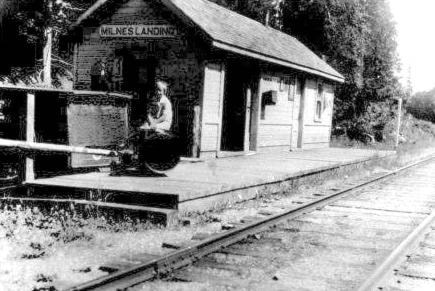Elide Peers | Contributed
Back in the 1920s, freight was often carried via the Canadian National Railway from Victoria to supply Sooke.
The Milne’s Landing Station, pictured here in 1927, stood a bit west of where Meota Drive meets Sooke River Road. This area is frequented by hikers nowadays, as the Galloping Goose corridor (originally the route of the CNR) intersects with Sooke River Road a couple of times.
The little girl perched on the oil barrel is Jean Kitching, who accompanied her dad to the station to wait for the puffing steam locomotive, bringing a shipment of grocery and dry goods supplies.
READ: Whiffin Spit named after Royal Navy clerk
At that time, the Kitchings and their partners, the Hardys, operated the Kitching & Hardy grocery store at the northwest corner of Sooke Road and Otter Point Road. Eustace Arden originally built this structure in 1909 and it still stands today, and now houses a restaurant.
Eustace Arden had also operated a horse-drawn stage, and it was in that fashion that groceries had initially been brought to stock his general store. In the time of pioneers, transport of merchandise from Victoria to Sooke had been by sailing schooner or sloop, so when rail transport became available, it was seen as a significant advancement.
Near the station stood a cottage that housed the CNR section foreman, Ernest Hillen, and his family. Small vehicles called “speeders” were used for quick transport along the rail line as well, and we recall hearing that sometimes the speeders were used for hi-jinks.
Sooke resident Danny Eddy grew up on Sooke River Road in the 1950s, and he recalls he and his buddies having the opportunity for speeder jaunts along this route as far as Colwood for a bit of fun, returning with no one the wiser.
The other CNR station, which was familiar to us, was built alongside the track approximately where Saseenos Road meets the CNR/Galloping Goose route, a bit east of Woodlands Road, where there was also a siding loading Alf Brown’s poles. After hauling logs, lumber and poles from the Sooke hills’ uplands, the rail line, converted from steam locomotives to diesel, was in use transporting munitions from Cowichan Bay to Rocky Point in the 1960s.
In 1987, the Capital Regional District leased the province’s corridor and established the very popular hiking trail as far as Leechtown.
•••
Elida Peers is the historian of the Sooke Region Museum.
editor@sookenewsmirror.com
Like us on Facebook and follow us on Twitter
